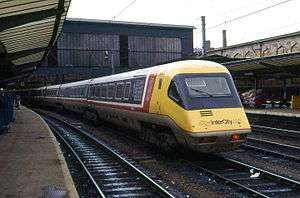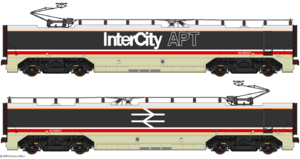British Rail Class 370
| British Rail Class 370 Advanced Passenger Train–Prototype | |
|---|---|
 370003 at Carlisle | |
| In service | 1980-1986 |
| Manufacturer | BREL |
| Built at | Derby Works[1][2] |
| Family name | APT |
| Entered service | 1979[3] |
| Number built |
|
| Number preserved | 7 cars |
| Formation |
|
| Diagram |
|
| Fleet numbers | |
| Operator(s) | InterCity |
| Depot(s) | Glasgow Shields Road[5] |
| Line(s) served | West Coast Main Line |
| Specifications | |
| Train length | 482 ft 0 1⁄2 in (146.93 m)[2] |
| Height | 3.5 m (11 ft 5 3⁄4 in) |
| Maximum speed |
|
| Weight | 434 tonnes (427 long tons; 478 short tons) |
| Traction motors | 4 × Asea LJMA410F[2] |
| Electric system(s) | 25 kV 50 Hz AC Overhead |
| Current collection method | Pantograph |
| UIC classification | 2'2'2'2'2'2'2'+Bo'Bo'+Bo'Bo'+2'2'2'2'2'2'2' |
| Bogies | BP17a, BT11 and BT12[2][4] |
| Braking system(s) |
Air/hydrokinetic[6] Electronic control[4] |
| Coupling system |
Automatic tightlock (M) Automatic drophead buckeye (DTS) Bar (other)[4] |
| Multiple working | Within class only |
| Track gauge | 1,435 mm (4 ft 8 1⁄2 in) standard gauge |

British Rail's Class 370 tilting trains, also referred to as APT-P (meaning Advanced Passenger Train Prototype), were the pre-production Advanced Passenger Train units. Unlike the earlier experimental gas-turbine APT-E unit, these units were powered by 25 kV AC overhead electrification and were used on the West Coast Main Line between London Euston and Glasgow Central. The APT-P is the most powerful domestic train to have operated in Britain, the eight traction motors fitted to the two central Motor Cars giving a total output of 8,000 horsepower (6,000 kW). This enabled the train to set the UK rail speed record of 162.2 miles per hour (261.0 km/h) in December 1979, a record that stood for 23 years until an InterCity 225 set reached 162.6 miles per hour (261.7 km/h) in a test run on Stoke Bank.[7]
The APT-P was unveiled to the public on 7 June 1978 and continued to be used for testing into 1986.[5] Due to ongoing technical problems with these pre-production units, and a lack of cash or political will to take the project forward, the planned APT-S (Advanced Passenger Train Squadron Service) production-series units were never built, but did influence the design of the later InterCity 225 sets designed for the East Coast Main Line electrification. The influence is strongest with the Class 91 locos which took many features from the APT powercars. The technology was later sold to Fiat and used for improving their second generation Pendolino trains which have been used worldwide, including the West Coast Main Line.
Numbering
Units were numbered 370001-370006 (plus two spare cars labelled 370007)[3] and were formed as follows:
- 48101-48107 - Driving Trailer Second
- 48201-48206 - Trailer Second
- 48401-48406 - Trailer Restaurant Second Buffet
- 48301-48306 - Trailer Unclassified
- 48501-48506 - Trailer First
- 48601-48607 - Trailer Brake First
- 49001-49006 - Non-Driving Motor[3]
A full train was made up of two units running back-to-back, with the two motor cars adjoining. The motor cars had no seating accommodation or through-gangway, so the two halves of the train were unconnected for passengers.
Withdrawal
All six units were withdrawn during 1985-1986, and most cars were quickly scrapped. The remaining cars are exhibited at Crewe Heritage Centre, a museum located next to Crewe station.[1]
- Of these, six cars are formed into a single train:
- 48103 - Driving Trailer Second
- 48404 - Trailer Restaurant Second Buffet
- 48603 - Trailer Brake First
- 49002 - Non-Driving Motor
- 48602 - Trailer Brake First
- 48106 - Driving Trailer Second
- A single Non-Driving Motor car does not form part of the train and is exhibited separately:
- 49006 - Non-Driving Motor (not part of the above train) was on loan to the Electric Railway Museum in Coventry from July 2011 until its closure in October 2017 and has been moved back to Crewe by March 2018.[8]
See also
References
- 1 2 "Advanced Passenger Train – Prototype". The Crewe Heritage Centre. Retrieved 1 December 2015.
- 1 2 3 4 5 6 "Class 370 (Advanced Passenger Train)". The Railway Centre. Archived from the original on 21 August 2008. Retrieved 31 January 2016.
- 1 2 3 4 5 Marsden 1983, pp. 119-120
- 1 2 3 4 "Vehicle Diagram Book No.210 for Electrical Multiple Units (including A.P.T.)" (PDF). Barrowmore MRG. BRB Residuary Ltd. Retrieved 31 January 2016.
- 1 2 "Testing the APT-P". traintesting.com. Archived from the original on 17 January 2016. Retrieved 1 February 2016.
- ↑ "British Rail's Advanced Passenger Train" (PDF). The Railways Archive. Retrieved 1 February 2016.
- ↑ "Train smashes speed record". BBC News. 30 July 2003. Retrieved 2 June 2010.
- ↑ "BR 49006 25 kV AC Advanced Passenger Train Motor Car built 1978". Vintage Carriages Trust. 6 August 2018.
Sources
- Marsden, Colin J. (1983). Motive Power Combined Volume. Ian Allan. ISBN 0711012849.
Literature
- APT-P: The Intercity Development Train Publisher: British Railways
- The Shape of Travel to Come Publisher: British Railways
- British Rail's Advanced Passenger Train Publisher: British Railways
- APT Course Notes Publisher: British Railways Scottish Region
Further reading
- Body, Geoffrey (1981). Advanced Passenger Train. Weston-super-Mare: Avon-Anglia Publications. ISBN 9780905466378. OCLC 16538327.
- Nock, O.S. (1980). Two Miles a Minute. Cambridge: Patrick Stephens Ltd. ISBN 9780850594126. OCLC 7173075.
- Williams, L.H. (1985). Advanced Passenger Train: A Promise Unfulfilled. London: Ian Allan. ISBN 9780711014749. OCLC 16684893.
- Trains in the Eighties, 1: Inter-City 125s & APT. London: Ian Allan. 1980. ISBN 9780711010918. OCLC 43747550.
- Clough, David N. (2016). APT: The Untold Story. London: Ian Allan Publishing. ISBN 9780711038240.
- Haresnape, Brian (1983). British Rail Fleet Survey 5: High Speed Trains. London: Ian Allan. ISBN 9780711012974. OCLC 153032242.
- Derrick, Kevin (2010). Eighties Spotting Days, Out of the Ashes. Strathwood. ISBN 9781905276301.
- Kelly, Peter (February–March 1982). "Ladies and gentlemen, we have a total failure". Rail Enthusiast. EMAP National Publications. pp. 38–40. ISSN 0262-561X. OCLC 49957965.
- Allen, Geoffrey Freeman (February–March 1982). "Why APT is running nine years late". Rail Enthusiast. EMAP National Publications. pp. 41–43. ISSN 0262-561X. OCLC 49957965.
- "End of the line for prototype APT". Rail Enthusiast. EMAP National Publications. May 1983. p. 16. ISSN 0262-561X. OCLC 49957965.
- "APT: BR puts the record straight". Rail Enthusiast. EMAP National Publications. November 1983. p. 19. ISSN 0262-561X. OCLC 49957965.
External links
| Wikimedia Commons has media related to British Rail Class 370. |